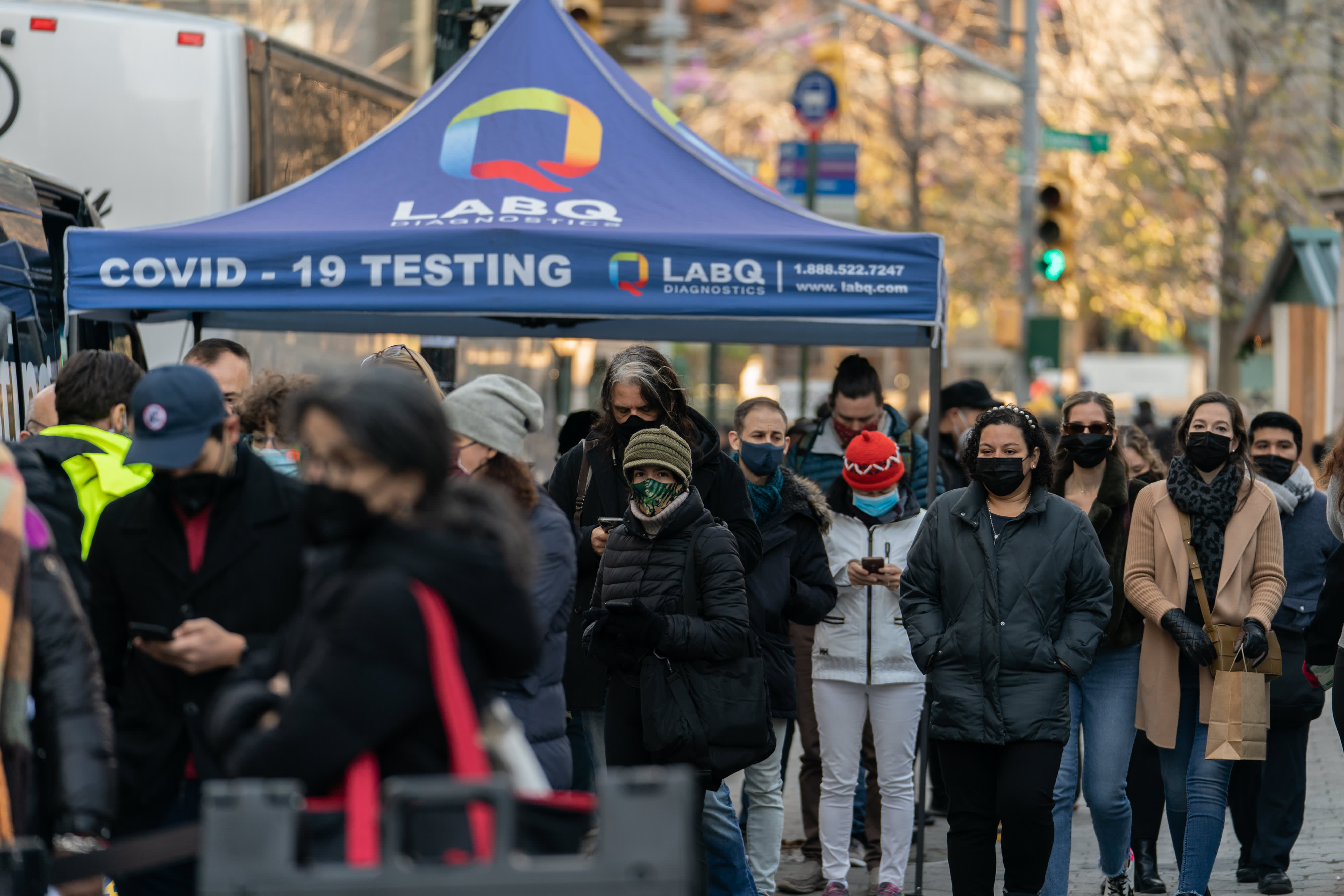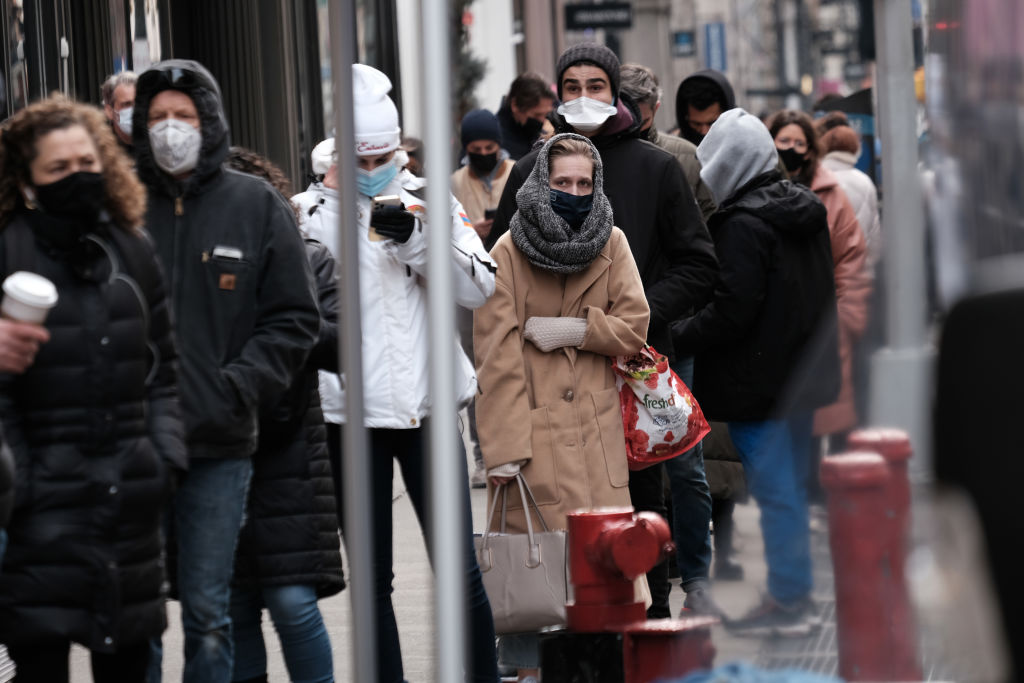What to Know
- NY COVID-19 hospitalizations have now soared to late February highs, Gov. Kathy Hochul said Monday; daily positive cases were down but that's likely because of reduced testing over the holiday weekend
- Concerns around pediatric COVID hospitalizations are growing, especially in the city; admissions among NYC kids are up 395% since the week of Dec. 5 vs. a 163% increase statewide
- The omicron variant is linked to milder COVID cases, which officials say is enough reason to avert panic; still, the surging infections are decimating workforces across all industries in NY and nationwide
New York state COVID hospitalizations ballooned over the Christmas holiday, topping 5,500 for the first time since late February, Gov. Kathy Hochul said Monday, and while daily cases were considerably lower than the record-shattering highs of the last 10 days, a more accurate picture on that front is expected in a day.
As of Monday, statewide hospitalizations stand at 5,526, the highest total since February 23 and a near 190% increase since Nov. 1 alone. That's still well short of the 7,000 New Yorkers who were hospitalized with COVID this time last year, and the sheer volume of omicron infections will likely translate to some more severe cases by default, especially among the unvaccinated, Hochul says.
More troubling than the numbers themselves is the population among whom there has been a "striking increase" in admissions as of late: Children.
Get Tri-state area news and weather forecasts to your inbox. Sign up for NBC New York newsletters.
Pediatric hospitalizations are becoming an increasing point of concern as well, according to data Hochul shared Tuesday. COVID admissions for kids are now up to 184 statewide, 109 of them in New York City. Two weeks ago, there were 70.
Dr. Mary T. Bassett, the state health commissioner who suffered a breakthrough COVID case last week but was masked, 6 feet from the governor in Monday's briefing, said pediatric COVID hospitalizations have doubled in the last three weeks. In New York City, they've quintupled in that time span, she said.
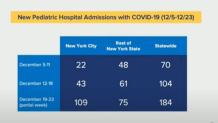
Among the 5-to-11-year-olds in the hospitalized group, none had been vaccinated, Bassett said. About a quarter of older kids recently hospitalized had been vaccinated, she said. Both vaccination rates are well below the averages in the New York population overall, which officials again say shows the power of vaccines to prevent severe COVID-related disease in all age groups, including the youngest.
"Many people continue to think that children do not become infected with COVID. This is not true. Children become infected with COVID and some will become hospitalized. The vaccination coverage remains too low," Bassett said. "We need to get child vaccinations up, particularly in the 5-to-11-year-old age group."
As of the latest CDC data, New York kids in that age group, which only became eligible for vaccination on Nov. 3, have a 16.4% complete inoculation rate. About 27% have at least one dose. The numbers are significantly higher for kids aged 12 to 17 (66% and 75.1%, respectively), but still not as high as officials would like.
Bassett and Hochul said they were sharing the pediatric hospitalization data in blunt view Monday in hopes it would motivate parents to use the school holiday break this week to get their kids the first dose if they haven't yet or move on to the second dose if the requisite three-week window has elapsed.
"Please do this for them," Hochul urged parents. "Using this time to get this done is really smart."

On the overall high -- and still increasing -- hospitalization count, Hochul said New Yorkers can take some comfort that the numbers aren't where they were in April 2020 or even where they were this past January. But they are soaring upward.
"That is something we're very cognizant of and have been anticipating and preparing for," Hochul said.
Among actions already undertaken as part of its winter surge plan, the state has paused non-essential elective procedures in hospitals with limited bed capacity (10% or less), expanded the eligible healthcare workforce, deployed the National Guard to nursing homes and reallocated hospital staff to high-need areas. Roughly 25 hospitals are on that "paused" list of now, though the number vacillates.
Of the overall winter surge plan, Hochul said, "it's been working right now," leaving open the question of whether it will be sufficient to sustain the state throughout.
"We're going to continue to be vigilant," the governor added. "I want all New Yorkers to know that we have a very experienced team here. People know what they're doing. They are pulling every single lever available to us, and we're committed to getting this done and doing everything we can to help save lives."
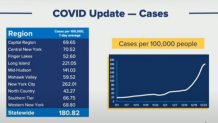
Daily positive cases in New York topped out around 26,000 a day ago, Hochul said Monday, though she essentially dismissed that number as vastly underestimated given reduced testing over the weekend. She expects the daily count to rise by up to 20,000 or more by the time Tuesday's data comes in -- and says that's no surprise.
"I have to acknowledge, the numbers are continuing to climb. This has not been a surprise to us, particularly since we started taking precautions, warning about the winter surge since early October ... and also knowing full well this could be a very vulnerable time given how quickly this mutation, omicron, transmits," Hochul said.
Omicron accounted for more than two-thirds of genetically sequenced positive COVID samples uploaded to GISAID, the world's largest repository of COVID-19 sequences, over the last two weeks. That's up from 62.4% in the last day -- and from 11.1% in the two-week period from Dec. 5 to Dec. 18, state data shows.
CDC data for the latest two weeks has not yet been updated, but the agency's modeling estimated omicron accounted for more than 90% in the New York area.
While the true number of COVID-positive New Yorkers on any given day is unclear for a number of reasons, omicron has clearly asserted itself as the most infectious variant to date. Testing demand has grown so intense people are literally climbing over one another, hands outstretched, in a bid to land free at-home kits.
New testing sites continue to open, but it isn't always a smooth operation. A promised site in Kew Gardens never opened on Monday. Another site on the Lower East Side was so poorly marked, people didn't even know there was a testing site inside — while a line for testing at an urgent care center in the same neighborhood had lines stretching down the block.

Hochul on Monday repeated the same mantra she has in every COVID briefing she has done over the last month as numbers have spiked, saying, "This is not March of 2020. We have tools at our disposal. The question is how we're deploying them."
New York, like many states, has seen hours-long lines for COVID testing amid soaring national demand. Hochul says the state sent 600,000 tests to New York City at the end of last week and is working to bring more direct resources. She said Monday the state had ordered 37 million testing kits and was awaiting full delivery.
Up to 3.5 million COVID tests due to arrive in the state have been pre-allocated to schools, 2 million of them to New York City, the nation's largest public district. She said the state will leave it up to schools whether the tests are performed in schools, or are sent home with the children.
"We want to make sure schools stay open. Most cases are not being transmitted in schools. We want them vaccinated, we want them boosted. But we understand it's not a good option to say children are going to be returning home again," Hochul said -- though for the first time since she was sworn in said, "subject to change."
Five more testing sites will open this week, one in each borough. The state has also launched 37 new pop-ups and plans 17 more in New York City. Another 13 test sites launch across the state Wednesday. Appointments opened for advance scheduling on Monday, though most slots for this week appeared gone by 10 a.m.
President Joe Biden has pledged federal mega-sites to open soon across the U.S., including in the hard-hit New York area, though it's not clear exactly when those will open. It's also unclear where they will be located.
Meanwhile, millions are preparing to travel home now that the Christmas holiday is over -- although cancellations during the busiest travel season are sure to complicate matters. Many of the major airlines have confirmed an increase in COVID sick calls in recent days, forcing the cancellations of more than 1,000 flights over the holiday weekend. New York-area airports have seen hundreds of cancellations and delays, fueled both by COVID and winter weather in the West.
In response to the rapidly shifting terrain and current dominant variant, Hochul on Friday announced modifications to New York's return-to-work COVID policies for essential workers by shortening the period of required isolation to five days.
More Coverage
That shortened window applies to essential workers who are both fully vaccinated and asymptomatic as well as to fully vaccinated workers who had mild symptoms that resolved and no fever for 72 hours without fever-reducing medication, Hochul said. They also have to wear masks upon return. Testing is not required.
"This is not about sending people back to work who are sick," Bassett said at a news briefing Monday. "People who are sick, at all times, should not be at work, and in these times in particular."
See the state's complete updated return-to-work guidance for essential personnel here, as well as who is defined as essential personnel.
The tweak incorporates the latest guidance from the CDC, which shortened its recommended isolation window for healthcare workers a day ago, and the milder infections with omicron, which are knocking out huge chunks of workforces just because of high positivity rates alone. Many such positive workers don't show symptoms or show mild symptoms and do not need medical treatment to recover.
Hospital managers, including the head of the largest public health care system in the U.S., Dr. Mitchell Katz of NYC Health + Hospitals, say they're wary about staffing shortages for similar reasons -- and far more than they're worried about an influx of people seriously sick with omicron. That's what Hochul is trying to accommodate.
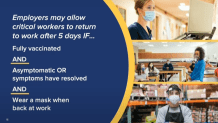
"Positive cases don't necessarily mean that you are too sick and require hospitalization. We just have to again, manage," Hochul recently said. "This is not delta. This is not the first variant. This is omicron which thus far, and again I have to qualify this, thus far, has demonstrated as we've watched around the globe and other places where it hit first, that it's not as severe in its impact."
Still, hospitalizations, especially among the unvaccinated, are continuing to rise, Hochul noted earlier in her briefing. The state recorded another 132 combined COVID fatalities on Saturday and Sunday, numbers mercifully well below the roughly 800 New Yorkers who were dying a day at the pandemic's peak in 2020.
Both metrics are to be monitored closely, Hochul said.
Ultimately, officials say vaccinations will quell the increases in hospitalizations and deaths associated with the omicron wave -- and those metrics are a much greater concern for them than infections alone. That's why they're urging calm at this time -- and pushing vaccinations and COVID boosters for those who have to get them.
The state has administered 3.2 million vaccine doses since Dec. 1 alone, but lagging rates between full vaccination and first doses for adults especially (82.6% vs. 95%) are becoming a point of concern, the governor said.
"We should be catching up with that, so I'm urging everybody, if you had the one dose, be aware you're on a process. You're not there yet. You're not protected, particularly against omicron, which is just breaking through," Hochul said.
New York City's new vaccine mandate, which expanded to the whole private sector on Monday, could be an interesting case study on that front. Mayor Bill de Blasio, Hochul and others have long said that if someone gets a first vaccine dose, the belief is that the individual will go back to get a second dose.
Now, private employers across from the five boroughs must affirm proof of at least one vaccine dose for each employee -- and get a second-dose scheduling commitment within 45 days of the first. Time will tell how that element plays out - and de Blasio will be well out of his mayoral office before any trends there emerge.

